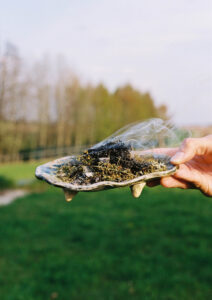When taking the train from the Polish capital of Warsaw to Motycz—a small village in the east of the country—there is a point where you leave concrete behind and enter the heart of the forest. Here, sunlight glimmers through branches, and trees start dancing. For an urban dweller, it can feel surreal to be surrounded by towering trees, with their leaves all different shades of green. But humans have had a special relationship with nature since the beginning of our very existence. Its bounty has been a part of our lives, from the places we lived to the food we consumed.
Plants extend nature’s influence even further, to the realm of medicine. In the past, herbalists—like Ilona, who is a passionate phytotherapist with a background in clinical psychology—would prescribe herbal medicine consisting of leaves, flowers, roots or bark. The secrets of plants and how to use them date back to paleolithic times, and cave art dated at 30,000 years old shows evidence of shamanic practices.
Sumerian herbalists used willow bark, which contains salicin—a chemical similar to aspirin—as a painkiller. Across the Mediterranean Sea, Roman herbalists used mugwort to make antibacterial ointments for healing wounds. The practice of using herbs was not only limited to healers. For example, mothers used poppy seeds to calm babies and placed hop cones on pillows to help children sleep.
If you were to enter a traditional Slavic hut in the 6th century, you would be welcomed by herbs placed above the door to keep the energy of the house clean. Grandmothers would teach their granddaughters in these huts. Every summer, they would take them to witness the ritual of “watering” herbs—a ceremonial worship of Mokosz, the Goddess of Earth and protector of women and children.
In the 10th century, female herbalists lived in fear. They had to know how to read herbariums—the encyclopedia of herbs—and at that time, a woman who read posed a danger to the patriarchal social order. They ran the risk of being accused of witchcraft and put to death. Naturally, the trade dwindled over time.
Today, Ilona is on a mission to help people reconnect with nature, and ultimately with themselves. “Herbology can help us understand ourselves and our bodies on many different levels,” she says.
Ilona combines knowledge from her degree in clinical psychology with herbology and runs her own practice. Her workshop hut showcases a rustic wooden table, a kitchen with a stove, and a beautiful display of herbs. According to Ilona, one of the biggest problems of our society is consumption: “We eat but do not nourish. Herbology teaches that one should use nutrients that grow within the radius of a two-day walk from their place of birth. A good quality butter or lard will provide the same amount of omega-3 oil as coconut oil. Locally grown potatoes with linseed oil and a sprinkle of fresh herbs could give better nutrition than superfoods imported from abroad.” Herbs can also help treat stress and stress-induced diseases. A mixture of herbs based on lemon balm and valerian can calm the body and decrease the production of hormones such as thyroxine, which keeps the body alert.
Herbs were part of our ancestors’ daily routines, so why can’t they be part of ours?



